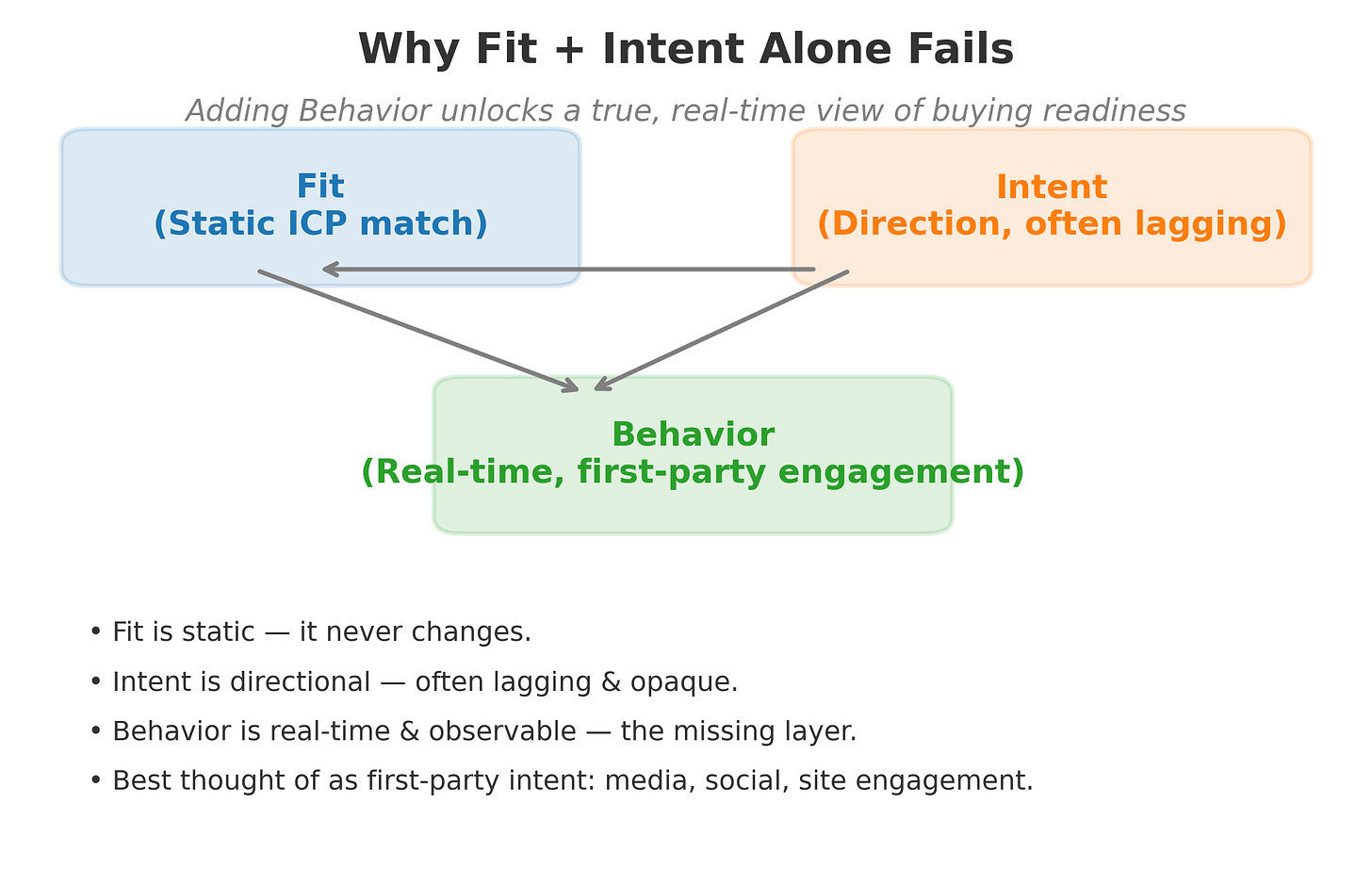The Account Scoring System That Beats Fit + Intent Alone
Why most ABM scoring models leave money on the table — and how to build one that powers smarter targeting, better creative sequencing, and higher conversion rates.
Why Fit + Intent Alone Fails
Most B2B account scoring models are built on two pillars:
Fit — How closely the account matches your ICP (industry, company size, tech stack, geo).
Intent — Whether they’re showing signals of researching topics related to your offering.
Those are useful, but they’re static (fit never changes) and directional (intent hints, but doesn’t confirm in-market readiness). In fact most third party intent scores are at best lagging indicators and at worst too far behind to add any real value, negating the value of point 2. We’re also putting a lot of faith in a metric that we’re unlikely to really understand - all of which mandates an upgrade…
The missing layer? Behavior — real, observable engagement signals that track how an account interacts with you right now. I often see these as first party intent - the most valuable signals in many ways. These signals span media you buy, realtime interactions with your brand across the web (social etc) and on your owned website properties
Example:
I’ve seen accounts with perfect fit scores and sustained intent signals vanish because only one junior buyer was engaging, and that person left the company mid-cycle.
I’ve also seen “meh” fit accounts accelerate from first touch to deal in under 30 days because four buying committee members started hitting pricing pages, integration docs, and high-intent content within a single week.
For all the talk of slow sales cycles in B2B, the second point aptly demonstrates that businesses can move fast when there’s a strategic need. To me, this clearly illustrates that we need the agility to react to behavioural signals fast because they are the giveaways on account progression
Static fit and vague intent don’t explain that — but behavior does. Without the third layer you likely miss the sale
💡 Get the Full Account Scoring Playbook
What you’ve read so far is the why. If you want the how — the actual formula, inputs, weights, and ready-to-use model — it’s all inside my new ebook:
📘 The B2B Account Scoring Playbook: From Signals to Sales
Inside, you’ll get:
The exact scoring formula I use to blend Fit + Behavior + Multipliers.
50+ scoring inputs mapped to funnel stages.
Real-world examples from high-performing ABM campaigns.
An editable scoring template you can plug into Salesforce, HubSpot, or The Trade Desk.
👉 Grab your copy on Gumroad here
This post gives you the context — the Playbook gives you the system.
The Three Pillars of a High-Performance Scoring Model
A winning account score blends Fit, Behavior, and Multipliers:
Fit Signals (Max 50 points)
Firmographics: industry, size, HQ location. These remain a key cornerstone
Tech stack: compatible platforms, competitive tools in use.
ICP match tiering: Tier 1 (direct match), Tier 2 (adjacent), Tier 3 (opportunistic).
Behavioural Signals (Max 30 points)
Website HVAs (e.g., “Contact Us” submission, case study download, pricing page view). These are micro conversions
Ad engagement depth (viewable completions, multi-creative exposure, attention time). I increasingly prefer to anchor this off of attention metrics, because these normalise omnichannel activity and don’t penalties non-click channels like CTV and audio
Content category engagement (product vs. thought leadership vs. support material).
Multipliers (Max 20 points)
Recency curve — last 7–14 days activity gets more weight than 30+ days old. If LLMs distort the buying signals, keeping prospects off your site for longer then we need greater reactivity
Buying committee diversity — more unique visitors from the account = higher score.
Omnichannel lift — if activity spans web, CTV, email, and events, score jumps. This is a marketing mix in play and we shouldn’t underestimate the value in nurturing an account across major addressable channels
You have reached the end of the free subscriber part of this article. In the below paid for sections, I cover;
The scoring model I use for B2B clients
Worked examples and a Google Sheet swipe file to build out your scores rapidly
How to apply scores across media buying, sales and marketing
Upgrade to paid today to access the content below immediately
Keep reading with a 7-day free trial
Subscribe to The B2B Stack to keep reading this post and get 7 days of free access to the full post archives.


